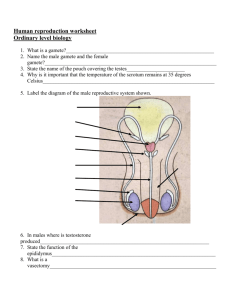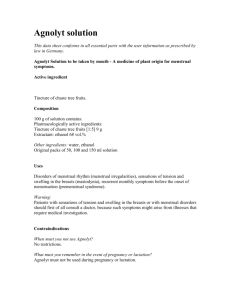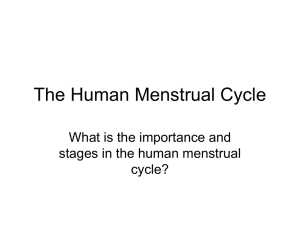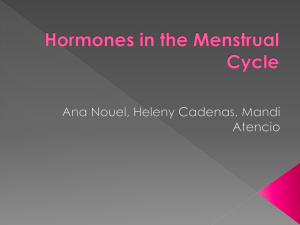File menstrual cycle lab
advertisement
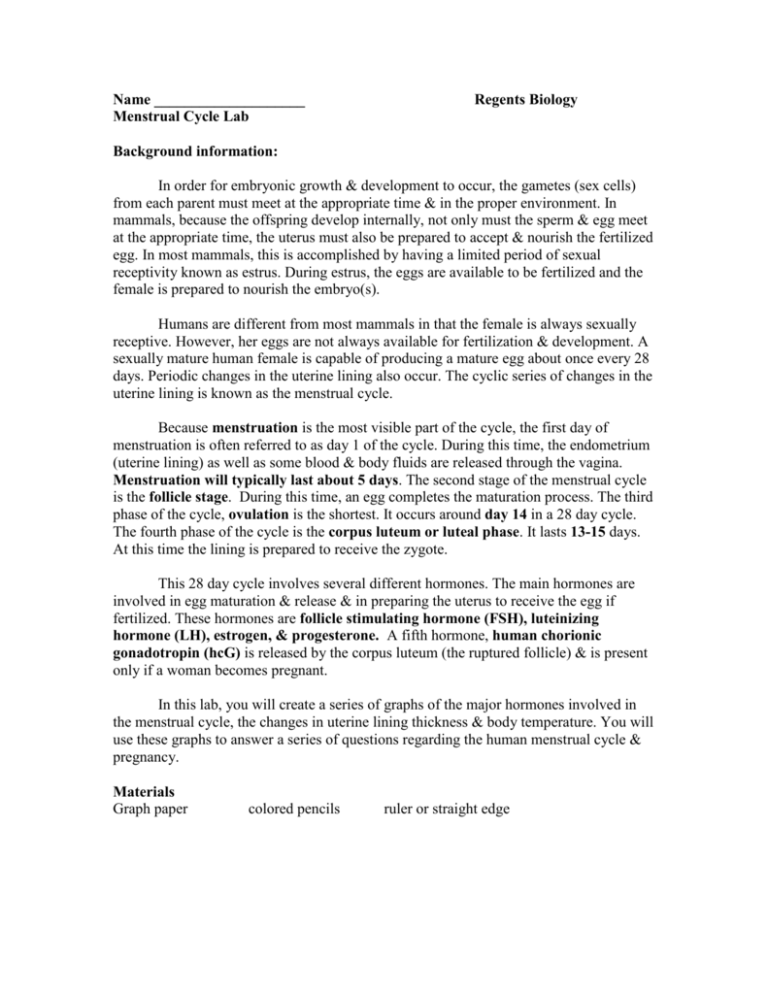
Name ____________________ Menstrual Cycle Lab Regents Biology Background information: In order for embryonic growth & development to occur, the gametes (sex cells) from each parent must meet at the appropriate time & in the proper environment. In mammals, because the offspring develop internally, not only must the sperm & egg meet at the appropriate time, the uterus must also be prepared to accept & nourish the fertilized egg. In most mammals, this is accomplished by having a limited period of sexual receptivity known as estrus. During estrus, the eggs are available to be fertilized and the female is prepared to nourish the embryo(s). Humans are different from most mammals in that the female is always sexually receptive. However, her eggs are not always available for fertilization & development. A sexually mature human female is capable of producing a mature egg about once every 28 days. Periodic changes in the uterine lining also occur. The cyclic series of changes in the uterine lining is known as the menstrual cycle. Because menstruation is the most visible part of the cycle, the first day of menstruation is often referred to as day 1 of the cycle. During this time, the endometrium (uterine lining) as well as some blood & body fluids are released through the vagina. Menstruation will typically last about 5 days. The second stage of the menstrual cycle is the follicle stage. During this time, an egg completes the maturation process. The third phase of the cycle, ovulation is the shortest. It occurs around day 14 in a 28 day cycle. The fourth phase of the cycle is the corpus luteum or luteal phase. It lasts 13-15 days. At this time the lining is prepared to receive the zygote. This 28 day cycle involves several different hormones. The main hormones are involved in egg maturation & release & in preparing the uterus to receive the egg if fertilized. These hormones are follicle stimulating hormone (FSH), luteinizing hormone (LH), estrogen, & progesterone. A fifth hormone, human chorionic gonadotropin (hcG) is released by the corpus luteum (the ruptured follicle) & is present only if a woman becomes pregnant. In this lab, you will create a series of graphs of the major hormones involved in the menstrual cycle, the changes in uterine lining thickness & body temperature. You will use these graphs to answer a series of questions regarding the human menstrual cycle & pregnancy. Materials Graph paper colored pencils ruler or straight edge Table 1: Hormone, Uterine lining & temperature data Day LH FSH Progesterone Estrogen 1 2 4 6 8 10 11 12 13 14 16 18 20 22 23 24 26 28 2 2 7 5 3 2 7 15 40 32 4 2 1 0.5 0.5 0.5 1 2 5 12 13 10 5 4 7 12 15 12 6 4 3 2 2 2 2 5 1 1 1 1 1 1 1 1 2 3 7 15 19 24 25 23 15 1 2 2 2 3 10 20 26 23 15 10 1 6 9 8 112 10 6 2 Uterine Lining Thickness 10 8 5 6 10 15 21 22 25 25 25 25 25 25 25 23 19 11 Temperature 98.0 98.1 98.2 97.8 98.0 98.2 98.1 97.9 97.8 98.8 98.6 98.7 98.6 98.5 98.6 98.4 98.3 98.0 LH= lutenizing hormone FSH= follicle stimulating hormone Hormones are measured in hormone units Uterine lining is measured in uterine lining units Temperature is measured in degrees Fahrenheit Procedure 1. Using one sheet of graph paper, label the X axis Days & the Y axis Hormone level. 2. Number the X axis 0-28 with each line equal to 1. 3. Number the Y axis 0-40 with each line equal to 1. 4. Title your graph Hormone Variations during the menstrual cycle. 5. Plot LH with a yellow pencil. 6. Plot FSH with a blue pencil. 7. Plot progesterone with a red pencil. 8. Plot estrogen with a green pencil. 9. In the space below the X axis of your graph, using the information provided in the introduction, label the 4 phases of the menstrual cycle: menstruation, follicle stage, ovulation, & corpus luteum stage. 10. Draw the following pictures of the follicle next to the appropriate data point on your graph. 11. Using a second sheet of graph paper, label the X axis Days & the Y axis Uterine lining thickness. 12. Number the X axis 0-28 with each line equal to 1. 13. Number the Y axis 0-25 with each line equal to 1. 14. Title your graph Uterine lining thickness during the menstrual cycle. 15. Plot Uterine lining thickness with an orange pencil. 16. In the space below the X axis of your graph, using the information provided in the introduction, label the 4 phases of the menstrual cycle: menstruation, follicle stage, ovulation, & corpus luteum stage. 17. Using a third sheet of graph paper, label the X axis days & the Y axis temperature. 18. Number the X axis 0-28 with each line equal to 1. 19. Number your Y axis 97.5 to 99.0 with each line equal to 0.1. 20. Title your graph Temperature variation during the menstrual cycle. 21. Plot temperature with a brown pencil. 22. In the space below the X axis of your graph, using the information provided in the introduction, label the 4 phases of the menstrual cycle: menstruation, follicle stage, ovulation, & corpus luteum stage. Questions 1. Since a woman is born with all of her primary oocytes (immature eggs), why must she be especially careful about exposure to chemicals, radiation, or drugs even before she becomes pregnant? 2. Use your Hormone Variations during the Menstrual Cycle Graph to answer the following questions. a. What is the function of LH? b. What is the function of FSH? c. What is the function of progesterone? d. What is the function of estrogen? e. What day does LH peak? f. What day does FSH peak? g. What day does progesterone peak? h. What day does estrogen peak? i. Why don’t all 4 hormones peak on the same day? j. Which of the 4 hormones graphed are released by the pituitary gland? k. Which of the 4 hormones graphed are released by the ovary? 3. On which day does the uterine lining reach its maximum thickness? Why must the lining be thick at this point in the cycle? 4. Besides affecting the uterine lining, estrogen increases the senses of taste & smell. a. During which phase of the menstrual cycle will a woman have heightened taste & smell? b. How would an increase in these senses be beneficial if conception occurs? 5. The corpus luteum (ruptured follicle) causes the release of progesterone from the ovary. What would happen if fertilization had occurred but the corpus luteum was not maintained beyond day 28 in the cycle? 6. Test kits are available for woman trying to conceive which predict ovulation one day in advance. What hormone are these kits testing for? 7. A pregnancy test uses a hormone that is present only if a woman is pregnant to confirm conception. What hormone is a pregnancy test indicating for? 8. Basal body temperature is another pregnancy indicator. If temperature remains high for 21 days after fertilization this is considered a positive indication of conception. a. During which phase of the menstrual cycle does body temperature increase? b. During which phase of the menstrual cycle does body temperature drop? c. Which hormone is causing the increase in body temperature?
